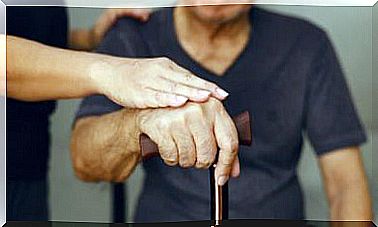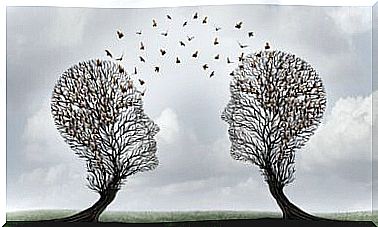The Bitterness Of Unshed Tears

Sometimes, a deep anguish invades us, a lump forms in our throat and our mind seems to be kidnapped in a dead end. Sadness comes on the scene, while impotence for what happened catches us. We can’t do anything, no matter how hard we try. Not even tears have the courage to peek through our eyes, to fall down our cheeks and help us vent. What’s going on? Why don’t we cry?
There are many people who after suffering a negative situation of great impact are unable to release their pain. What happened has moved them so much that, somehow, they have been blocked, locked in a suffering that robs them of any possibility of expressing how they feel.
It is a bitter feeling. They want to cry and they can’t ; they even wish they could put words to that which invades them, but they are incapable. The problem is that the discomfort is getting bigger and bigger; as if, little by little, the unshed tears were drowning them inside. Let’s go deeper.

Why can’t I cry
The inability to cry can be associated with various causes: from illness to emotional blockages ; hence, in the first place, it is important to rule out any causes at the physiological level.
For example, Sjögren’s syndrome is an autoimmune disorder characterized by the destruction of the glands that produce tears and saliva, although it can also damage other parts of the body. What causes symptoms like dry eye and mouth. For this reason, it is important to see a doctor, rather than assume that what happened is due to psychological problems, such as depression.
Psychological causes
Once the physiological causes have been ruled out, it is time to navigate through the psychological universe of the person to find out what happens. In this case, it is important to keep in mind that not all people handle problems in the same way. Each one has their own way of facing reality, their reaction times and their baggage of strategies. Therefore, there will be those who are able to release their emotions easily, those who need more time to process what happened and who, for some reason, are blocked due to the strong impact.
Thus, when the problem has a psychological origin, it is usually related to poor management of emotions. Which can be something specific, but also lead to depression along with other factors. Even if the impossibility of crying is experienced during a grieving process and it lasts over time, it could indicate the presence of a pathological grief.
However, it is important to keep in mind what it means to cry for the person, since, sometimes, there is a belief that it is something negative or of weak people, due to the education received. Hence, many people tend to repress it for fear of being considered as fragile or vulnerable, until it becomes an automatism. Or, they may even be afraid to come into contact with themselves. The problem is that this does not promote health and, sometimes, facilitates the accumulation of anger, rage and aggressiveness or even somatization.
The emotional release of tears
William Frey, a doctor at Saint Paul Ramsay Medical Center, says tears are as necessary as smiles. Although it is true that they do not have the power to resolve what happens to us, they ease tensions, relieve sadness and make it easier for the person to get to know each other and connect with others.
Tears are part of us, they are a defense and relief mechanism, that is, a way to release accumulated tension, regardless of the situation. Therefore, it is important to allow yourself to express them. Lauren Bylsman, a researcher at the University of Pittsburgh, affirms that crying helps the body return to its state of homeostasis, that is, to regain balance, after being disturbed.

According to a study carried out by biochemist William H. Frey, tears shed by a negative or dramatic situation release endorphins, prolactin, potassium and magnesium chloride, as well as adenocorticotropin and leucine-enkephalin. Thus, our discomfort, both physical and emotional, is alleviated due to the sensation that this emotional outburst produces.
Emotional relief techniques
Suppressing crying or being unable to cry leads to an accumulation of discomfort. It is like being adrift in an ocean of suffering, with no life preserver or land in sight. However, there are some strategies that can help us release the accumulated tension and, finally, begin to express our first tears:
- Empty of mind. It is a technique to descend into our depths. The first step is to ask yourself what makes us sad or what prevents us from feeling well. Once identified, we will try to answer ourselves in the first person: I feel …, it hurts me that … and then we will think about how to act in the future and what we could do to achieve the tranquility that we need so much.
- Therapeutic writing. Writing is a way of bringing out how we feel, that is, of releasing feelings and untangling that inner skein that paralyzes us so much. This exercise consists of writing about our feelings without thinking how it is. The important thing is to do it naturally.
- Review beliefs. Inquiring about our conception of crying is important. Perhaps we may discover certain restrictions or myths that if we banish them will allow us to cry. Thoughts such as “Crying is weak”, “Men do not cry” or “Crying is not going to solve anything” are an example of this.
- Talk to a trusted person. Turning to that person who listens to us, who welcomes us and supports us can be an option to feel understood and liberate how we feel. Now, not everyone is valid, but only those who give us confidence, security and calm.
As we can see, crying is a liberating and healthy act. It is capable of transforming the tension experienced into an expression of our inner world. It helps us to release the inner pressure of which, at times, we are prisoners; that is, it facilitates emotional discharge and relaxes us. In this way, we will begin to feel more secure and we will be able to observe what happened from another perspective.
In addition, tears also communicate; in fact, they are seen as a call to empathy and support from others. They appear when words fail to describe what the soul overflows, when we are unable to describe how we feel because of its intensity.
Crying is not a sign of weakness, but of courage. Of the courage to communicate the depth of our feelings, of how we find ourselves. As the American writer Washington Irving said “ There is something sacred in tears. They are not a sign of weakness but of power. They are the messengers of overwhelming grief and indescribable love ”.









